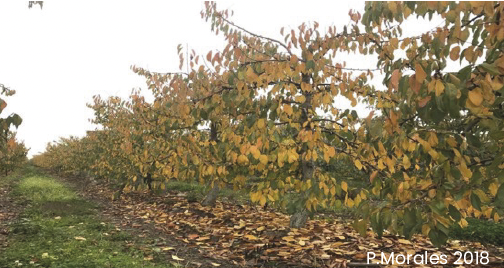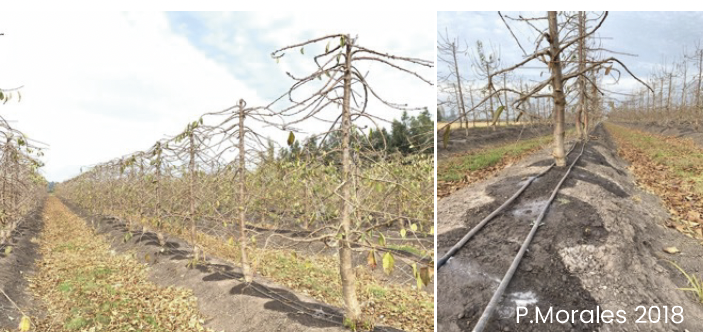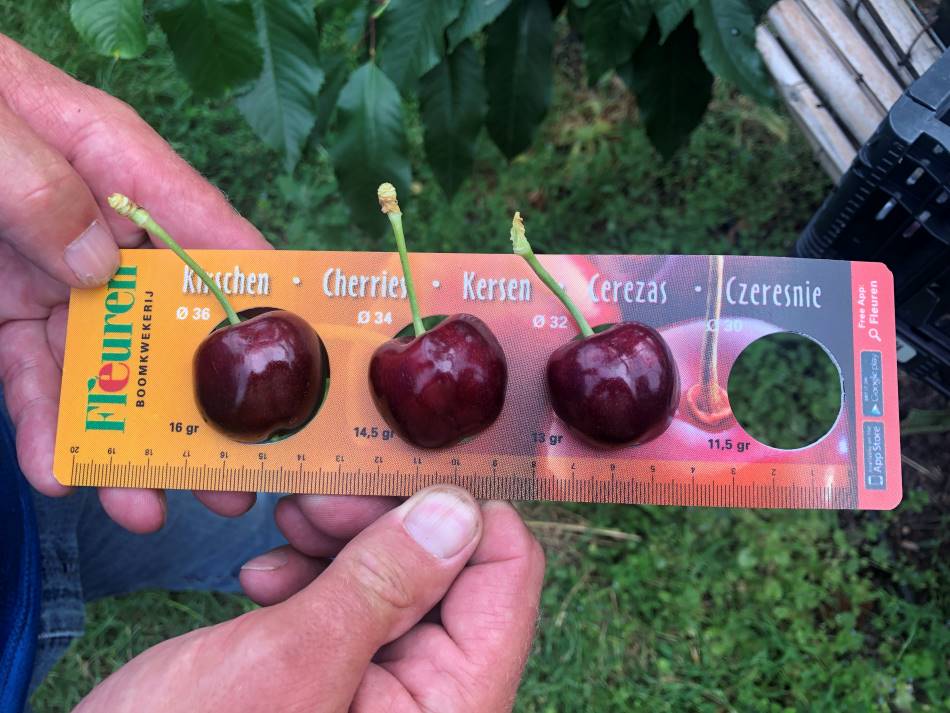During dormancy and leaf fall there are certain points to consider that are very important for the productivity of orchards, productivity that begins with the plants entering 'dormancy' correctly. This phase is fundamental and relevant for reaching full production potential.
As in other years, we had a very hot summer, so the plants tend to continue vegetating and being metabolically active, which is very negative due to the accumulation of reserves and a difficult entry into dormancy of the trees. In light of this, we should prepare our orchards for as normal an entry into dormancy as possible.
The trees should arrive on 1 May with 50% yellow or fallen leaves. Only at this point will the plants be receptive to the perception and accumulation of cold.
 Image 1: Dormant stages and cold accumulation.
Image 1: Dormant stages and cold accumulation.
More than 250 hours of cold must be accumulated in June (end-dormance) to meet the needs of the cherry tree. On the other hand, over the years, we have progressively seen that we are faced with winters with a lower quality of cold, so orchard management must be precise in order to obtain a good vegetative and productive result, especially in varieties with a higher cold requirement such as Bing, Regina and Kordia.
It must be considered that the phenological development of the first 30-40 days after full flowering is mainly the product of the carbohydrate reserves from photosynthesis that were generated and stored in the last post-harvest period.
When the plant recognises very long summers, the leaves and/or shoots want to continue to vegetate and in this period (March-April) with little or no generation of sugars from photosynthesis, so they have to 'feed' on the reserves already generated in January and March post-harvest, threatening optimal development from the following season's sprouting and flowering.
This aspect is often overlooked in analyses, but I personally believe that it is one of the main factors behind low yields after years of high yields and very long summers or very hot autumns.
The main climatic factor that allows the plant to prepare for low winter temperatures is the first autumn frosts or temperatures below 9°C. This allows the plant to create secondary growth through the process of lignification, also favouring the complete closure of the bud bracts.
Therefore, in years without early frost, plants are ill-prepared to face the coldest months of the year, and can damage poorly or badly lignified or hardened tissues and those fruiting centres (buds and twigs) that have failed to close their structures.
Consequently, all these factors affect a lower production potential. Furthermore, in years in which leaf fall is irregular, it is not possible to have good management of the control programme for diseases such as Pseudomonas syringae pv. syringae, as waiting for certain levels of leaf fall leaves orchards uncovered and with permanent conditions that favour infection.
To enter dormancy properly, important factors such as fertilisation, irrigation management and exogenous preparation for leaf fall must be considered.
 Image 2: Orchard in leaf abscission phase. A yellow leaf is equivalent to the time of leaf fall.
Image 2: Orchard in leaf abscission phase. A yellow leaf is equivalent to the time of leaf fall.
Irrigation management
Taking the above into account, the following management is suggested: do not irrigate after 30 March until 5 April, preferably in orchards with a lot of vigour and which still have a lot of vegetative activity, irrigate until 30 March and do not irrigate any more. It should be remembered that only the 'frequency' of irrigation should be changed by moving it away and not the number of irrigation 'hours'.
In areas that have already stopped irrigating due to water supply restrictions, they should no longer irrigate, even if water is available at short notice. Late irrigations after a 'dry' period could activate the plants again and this would be serious.
The limitation of irrigation water during this period is a key factor in initiating leaf maturation and lignification of other tissues, since the stimulus of low temperatures is not yet available to subject trees to recessive entry.
Winter irrigation
In the absence of rain in winter, we must create a 'wet winter' for our plants. It is very important to keep the pond soil full and in field capacity with hydrated and oxygenated soil. During the winter, the soil must be thoroughly wet, only if it does not rain for a long period of time.
 Image 3: Winter irrigation in cherry orchard.
Image 3: Winter irrigation in cherry orchard.
Exogenous preparation for leaf fall, redirection of reserves
With the aim of improving and enhancing the accumulation of reserves in post-harvest, slowing down vigour and stunting growth, it is recommended to apply a molybdenum-based product to give the plant the signal to start with the accumulation and redirection of photo-assimilates from the leaves to the roots and other structures such as stems and darts where reserves for the following season are accumulated.
This application, in combination with cytokinin, enhances cell division at the time of differentiation, improving and increasing the number of cells that form buds and darts, so that we enter the break with a better quality of reproductive structures that will be flowers and fruits in the following season. As we are facing warmer autumns, applications this season should start from 20 February, making 3 applications every 7 days.
| Product | Active ingredient | Dose /100L | Application period |
| Back Mo | Molybdenum + Boron | 150 cc | Apply 3 times every 7 days. First application 20 February. The products must be applied very evenly, mainly covering all tree growth points. Mix with cytokinin to improve floral differentiation.
|
| Molystar | Molybdenum + Phosphorus | 50 cc |
| Molytrac | Molybdenum | 50 cc |
| Molymax | Molybdenum + Phosphorus | 50 cc |
| Defender Mo | Molybdenum + Boron | 50 cc |
| Bilanciatore di nitrati | Molybdenum + Boron | 500 cc |
| Nutrafol molifos | Molybdenum + Phosphorus | 50 cc |
| Nano Mobo Plus | Molybdenum + Boron | 150 cc |
| Citostar | Benzyladenine + Algae | 100 cc |
| Stimulate Fruit Sizer | Kinetin | 100 cc |
| CitroGrower | Benziladenina + Alghe | 100 cc |
Caustic induction for foliar abscission
After the application of elements such as molybdenum, it is important to apply chemical agents that, by intoxicating the leaves, achieve leaf abscission, which allows us to concentrate on leaf fall, making disease control more efficient with the Cobres programme and biological products, considering that this stage is the most susceptible, along with the swollen shoot, to infection, especially by Pseudomonas spp.
| Application period | Product | Composition | Dose /100L |
| From 15 to 20 April | Granular urea
+
Zinc sulphate | Nitrogen 46%
Zinc 22,5% | 2kg
2kg |
A volume corresponding to the crown of each orchard should be used for application, so that every vegetative point of the trees is evenly covered.
 Image 4: Trees should arrive on 1 May with 50% yellow or fallen leaves.
Image 4: Trees should arrive on 1 May with 50% yellow or fallen leaves.
Bacterial cancer control programme during leaf fall and winter break
| Period | Product | Active ingredient | Dose /100L | Observation |
| Preceding leaf fall | Nacillus WP | Bacillus Subtilis y Brevibasilus sp | 100 gr |
|
| 50% of leaf fall | Wert | Bacillus metabolite + Copper (Cu) + Zinc (Zn) + Manganese (Mn) | 300 cc |
|
100 % of leaf fall, and every 25 days thereafter, after 40 mm of rain or following heavy frost | Nordox 75 WG | Copper oxide | 150 gr | Application of copper in winter always in a mixture with Mancozeb 80 WP in doses of 240gr/100L. |
| Cobre Premio WG | Copper oxide | 250 gr |
| Champ DP | Copper hydroxide | 250 gr |
| Hidrocup WG | Copper hydroxide | 250 gr |
| Cuprodul WG | Copper oxide | 250 gr |
| Wert | Bacillus metabolite + Copper (Cu) + Zinc (Zn) + Manganese (Mn) | 300 cc |
|
| Nacillus WP | Bacillus Subtilis y Brevibasilus sp | 100 gr | This application is important because it is the period most susceptible to pseudomonas infections |
| Wert | Bacillus metabolite + Copper (Cu) + Zinc (Zn) + Manganese (Mn) | 300 cc |
Control of xylophagous fungi during leaf fall and winter break
The wood disease control programme must be carried out as follows:
| Period | Product | Active ingredient | Dose /100L |
| Preceding leaf fall | Mamull WP | Bionecria ochroleuca
Trichoderma gamsii | 100 gr |
| Comet EC | Pyraclostrobin | 50 cc |
| Goldzadim 500 SC | Carbendazim | 80 cc |
| Yamato SE | Tretraconazole + thiophanate-methyl | 300 cc |
| In winter, mixed with copper application | Mancozeb 80 | Mancozeb | 240 gr |
Applications to control bacterial canker and wood diseases must be carried out with a volume depending on the orchard canopy of not less than 1,500 litres of water per hectare. Always check that the coverage is even, remembering that yellow or senescent leaves are equivalent to fallen leaves.
Once winter or summer pruning has begun, it is important to apply the following mixture indicated in the table immediately after pruning, on the same day or a maximum of 48 hours after pruning, which allows us to seal pruning cuts, which continue to be a source of infection for both wood diseases and bacterial cancer, and also to ensure better coverage of all cuts and pruning wounds. Apply no more than 48 hours after pruning.
| Period | Product | Active ingredient | Dose /100L |
| After pruning, max. 48h later. | Nacillus WP
+
Mamull WP | Bacillus Subtilis e Brevibasilus lechiniformis
Bionectria + Trichoderma | 100 gr
100 gr |
| Amistar top SC | Azoxystrobin + diphenoconazole | 50 cc |
Apply a volume of 1,000-1,500 litres of water per hectare, depending on the size of the trees, to achieve uniform coverage of all pruning cuts.
Trunk painting
To reduce bacterial ingress through micro-cracks in the wood caused by frost and where water accumulates, I suggest brush-painting the logs with the following mixture. Carry out this operation in orchards up to 4 years old.
| Product | Dose | Observation |
Caldo Bordeles 25 Valles
Bordo 25
(cuprocalcium sulphate) | 400 gr | Add water if the mixture is too thick, in doses of 1 to 2 litres. With 1 litre of mixture, approx. 20 plants with a trunk diameter of approx. 30 cm are covered.
|
White acrylic paint + Cold glue | 10 L
1 kg |
It is advisable to start varnishing the trunks now, from their base up to a metre in height and the 'axillary' part of the insertion of the first-storey branches, varnish profusely without leaving parts of the trunk unvarnished, do this especially in combinations of varieties and rootstocks that are more susceptible to infection by the cancer bacterium, such as CAB 6 P and Gisela 3, 5, 6 and 12.
I suggest carrying out this work up to the fourth year of the orchards' life and in adult orchards as required in combinations susceptible to the disease, passing over the insertion zone of the foreground branches.

It is important to consider the comments and recommended management, both to allow our plants to go into dormancy and rest, and to maintain the health of our orchards with disease control programmes. All of the above managements are essential to achieve the expected production potential, as well as to maintain the state of health as the main basis of economic success, which we all want to maintain over time.
Source: Asesorias en Carozos y Pomaceas
Images: Asesorias en Carozos y Pomaceas
Cherry Times - All rights reserved

















